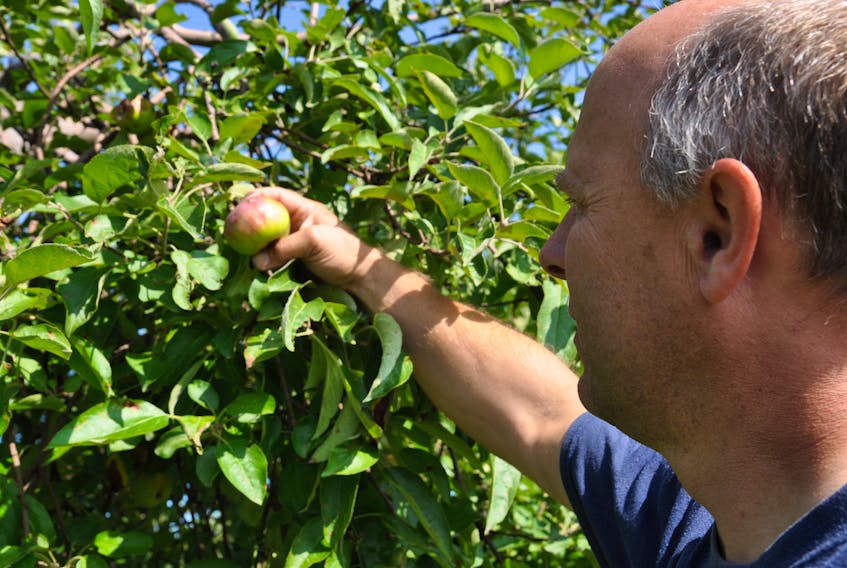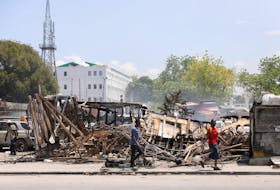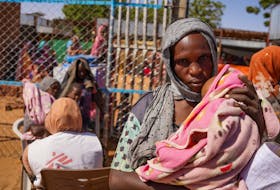WOODVILLE, N.S. – A Woodville farmer has lost his entire U-Pick fall apple crop following a heavy and unexpected frost in June.
Boates Farm owner Brian Boates says the frost wiped out 90 per cent of his apples – the biggest loss the farm has ever seen.
The farmer saw sagging trees laden with heavy frost as he looked out his window that June morning, and says what he’d feared was then realized as he sliced into fruitlets and found them brown and rotten.
“We’re apple farmers, and that’s the thing that drives it all, so to not have a crop of apples is devastating,” he says.
25 acres ruined
The June frost ruined more than 25 acres of apple trees and hit the farm’s best-selling apple varieties, Gala and Honey Crisp, the hardest. It also hit fruit on trees in flat, open areas particularly hard.
Apples on trees located on the farm’s higher ground, towards North Mountain, sustained less damage, and the farm’s crop of Bosc pears appears hardly damaged at all.
With just 10 per cent of the apple crop remaining, Boates is now looking to source processing apples from other local producers to continue their vinegar and sweet cider productions and offset their losses.
The farm is the only vinegar producer in Eastern Canada, so with production continuing and selling leftover stock from last year, Boates says the farm’s finances are looking alright despite the massive losses.
He worries the pinch will not be felt not this year, but as years continue, as funds go into preparing the trees for harvest before more profits roll in.
“We don’t have apples to market. We’ve never had a loss like this, and my biggest fear is that we’ll look back and say, ‘it took me five years to recover from that frost,’” says Boates.
“But as farmers we are resourceful – we’ll do what we can to mitigate it.”
Farming a ‘long-haul game’
Boates remembers only three weather incidents that decimated more than 50 per cent of his farm’s crop – two devastating frosts following both 1991 and 1992 winters, and Hurricane Arthur in July 2014.
With its most significant damages ever this year, Boates is glad his farm is insured under the province’s Crop and Livestock Insurance Commission, which will cover the farm’s business inputs.
He estimates less than 40 per cent of Annapolis Valley apple farmers carry this insurance, and that 30 per cent of these farmers were significantly affected by the frost.

“I don’t think we’ll have a shortage of apples. It’s more like individual farmers that will be in a tough spot because of this,” says Boates.
While weather events like June’s frost being unpredictable, Boates says newer, longer-range predictions are helpful as he plans and assesses strategies for readying the trees for upcoming growing seasons.
He says droughts now present the largest regular threat to orchards, as long, hot summers gradually become the norm. He also says hail remains a dreaded weather event, with one storm being enough to decimate an entire crop.
“Farming is a long-haul game. Apple farming is not like deciding whether you’re going to plant tomatoes, or a crop of potatoes next fall. It’s not a six-month thing,” says Boates.
Management key to regulating crops
Farmers like Boates plan for upcoming seasons a full year ahead since, since apple trees are biennial – often producing a big crop one year and a small one the next – and need regular maintenance to guarantee more regular crops.
Since this year’s crop is decimated, the trees will rebound next season with massive amounts of apples, says Boates, because they are currently without a crop.
“They’ll set themselves up for a big and heavy crop next year, because they’ve had the summer to rest. We’ll have to prune heavily to offset that,” he says.
Boates says farmers had been expecting a big crop of apples this year, ahead of the frost.
The industry is one that must plan ahead, since apple harvests are highly variable even without freak weather occurrences.
He says in any regular season, a crop can either half or double by harvest.
“In apple farming, you always seem to start the spring full of enthusiasm, and think, ‘this is going to be the greatest crop yet,’ and there’s always a few things that marginalize it or bring it down,” he says.
Climate change means more severe weather, more often: Duke
Random and severe weather events are fast becoming the norm as the planet’s climate continues changing, according to an expert at Acadia University.
Dr. David Duke, a professor of environmental history at Acadia University and Kings County resident, says this year’s June frost that decimated crops like grapes, apples and berries across the Annapolis Valley is among other weather phenomena that we should buckle up and get used to.
Duke says severe weather has always had a long and lasting impact on humans, like massive droughts in the seventeenth and eighteenth centuries that destabilized and eventually helped topple China’s Ming dynasty, along with spurring the Thirty Years War in Europe.
In Nova Scotia, people still remember historic weather events like 1816’s cold summer of frosts and snow, the 1869 winter Saxby Gale, and 1954’s Hurricane Edna, each of which caused mass devastation.
“The turbulent waters of the [Bay of Fundy] were forced into the narrow channel. Tides rose quickly to record levels, flooding waterfront streets in towns... Front Street in Wolfville [was] waist deep in water, damaging or destroying homes and businesses,” reads ‘The terrifying Saxby Gale,’ an article by Brian Rafuse written for The Regional Magazine in August 2000, describing some of the damage caused by the gale.
According to Duke, Edna was even worse, and caused $3 million in damage to the Valley’s apple crop.
“This was doubly devastating as it was the first really good crop since the end of the war and farmers were hoping it would re-establish them in European markets that had not been buying due to post-war austerity,” he writes in an e-mail.
Dukes says post-tropical storms and hurricanes like Edna will likely become the most frequent kind of severe weather in Nova Scotia, along with droughts and seasonal instabilities like this year’s June frost.
“It’s instability that is likely to be the hallmark of climate change for much of the rest of this century, leading more generally to warmer temperatures, and so it's that which we need to prepare for, now,” writes Duke.
Read the entire BACK ON THE FARM SERIES: A collection devoted to a vital industry in the Annapolis Valley:
- Centre Burlington man discovers passion for oldfashioned farming
- Falmouth farmers shift focus to find the right balance
- Eating healthy on a budget not as difficult in the Valley as one may think: dietitian
- Reporter spends a day at TapRoot Farms in Port Williams
- Diversification key to success for Wolfville farmer who took on grape growing, established winery
- Lawrencetown greenhouse grower diversified into grapes
- Dempsey Corner Orchards farmer sees longevity in trying new things
- Coldbrook farmer proudly commits to the 24/7 lifestyle
- Woodville apple orchards lose UPick crop to June frost
- Keith Colwell pushing food security, farming as a career, capitalization of new opportunities
- Acadia University scholars share their thoughts on sustainability in farming
- COLUMN: Tractors, train changed county farming forever









